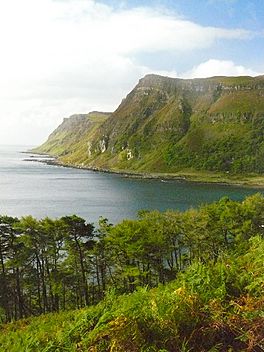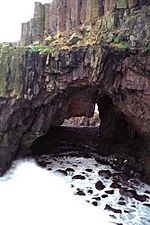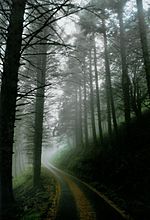Carsaig Bay facts for kids
Quick facts for kids Carsaig Bay |
|
|---|---|
 |
|
| Location | Isle of Mull |
| Coordinates | 56°19′13″N 5°58′43″W / 56.32028°N 5.97861°W |
| Basin countries | Scotland |
Carsaig Bay is a beautiful cove found on the Ross of Mull. This area is in the south of the Isle of Mull, which is an island off the west coast of Scotland.
The bay is about 5 kilometers (3 miles) east of Rudha Fhaoilean. It's also about 7.5 kilometers (4.5 miles) south of Pennyghael. You can reach it by driving along a narrow road.
Carsaig Bay is quite small. It is surrounded by tall, steep hills. It's not a very safe place for large boats. However, smaller boats can find a safe spot near the island of Gamhnach Mhòr. The eastern part of the bay has many rocks. Some of these rocks have markers to help boats get to Carsaig Quay. The ocean currents along the south coast of Mull are not very strong near Carsaig Bay.
Contents
Exploring Carsaig Bay's Landscape
Carsaig Bay is located on the southern coast of the Ross of Mull. It stretches from Rubh' a' Chromain in the west to Carraig Mhòr in the east.
You can get to the bay from the A849 road, which starts in Craignure. This road leads to a smaller, unclassified road about 15 kilometers (9 miles) east of Bunessan. The last part of this road is very steep and narrow.
The cliffs along this coast are very tall. At Rudha Fhaoilean, they reach about 290 meters (950 feet) high. The coastline from Rudha Fhaoilean to Rudha Dubh is mostly steep. However, Carsaig Bay offers some shelter because of Gamhnach Mhòr island. The cliffs are made of basalt rock. Some of these rock columns are very wide, about 2.1 meters (7 feet) across. The Carsaig Arches are natural rock formations. They are found west of the bay at Malcolm's Point.
Caves and Ancient History
One famous cave here is called the Nuns Cave. It is said that nuns from the Iona Abbey used to hide here. They were escaping from changes happening during the Reformation. Some of these caves might have been used as far back as the 6th century.
It is also believed that in the 15th century, monks from Iona Abbey visited these shores. They would collect stones washed up by the sea. Then, they would carve these stones into art and grave markers.
The natural forces of erosion have created a huge amphitheater here. It is made of basalt rock formations. These formations rise to about 215 meters (705 feet) high. At the end of the walking path, the large basalt columns reach about 240 meters (787 feet) tall. You can also see other interesting rock formations like weathered sills and dykes.
Finding Fossils
Fossils are often found in this area. The rocks here are from the Paleocene age. There are also Cretaceous rock layers. These layers include sandstones and mudstones. They also contain pieces of chalk. One notable rock formation is the Rubh' a'Chromain. It is made of felsite, basalt, and other rock pieces called xenoliths.
Plants and Animals of Carsaig Bay
The plants along the road to Carsaig Bay are very special. You can find wild strawberry plants and sweet-smelling woodbine.
When the tide is low in the bay, you might spot certain birds. These include oystercatchers and terns. Other animals reported in the area are wild goats. Look up to the sky, and you might see golden eagles and sea eagles. Birds like kittiwakes and fulmars also nest here.
Carsaig Bay in Movies
Carsaig Pier and its boathouses, along with Carsaig House, were important locations in a 1945 film. The movie was called I Know Where I'm Going!. You can also spot an unusual telephone box next to a waterfall in the film.




